FRANK ZAPPA MEETS THE MOTHERS OF PREVENTION: POLITICS
 On the "Does humor belong in music" DVD "Hot plate heaven" gets interrupted by an interview section and the solo isn't included (screenshot to the right).
The song's lyrics and the interview part are about Zappa's aversion of the Republican Party and his political ideas
would become more and more present on his albums and in his other activities. In 1985 he opposed the idea of parental
advisory stickers on rock albums, doing many interviews on the subject, and the 1988 tour had an outspoken anti-Republican
character. During the turnover in Eastern Europe he was seen by various people as a herald of intellectual freedom,
among them the newly elected president Vaclav Havel of Czechoslovakia. He visited Russia several times, trying to interact
for business deals. The zenith became his encounter with Havel, that reached the international press. In 1991 he talked a while about
the idea of running for president in interviews and doing a feasibility study. It was expressed at a time when the Republicans
were in office for quite a while and the Democrats failed in presenting an appealing alternative. Zappa considered
Reagan a moron and abroad Reagan was indeed seen by many as a caricature of the presidency rather than as someone with political insight.
Eventually no real steps were taken, nor any program items spoken of. His ill health at that time would
have ruled out campaigning anyway. Probably he was more interested in the publicity effect, than that he thought he had
any chance. The Libertarian party however had contacted him if he was interested in becoming a candidate on their behalf.
On the "Does humor belong in music" DVD "Hot plate heaven" gets interrupted by an interview section and the solo isn't included (screenshot to the right).
The song's lyrics and the interview part are about Zappa's aversion of the Republican Party and his political ideas
would become more and more present on his albums and in his other activities. In 1985 he opposed the idea of parental
advisory stickers on rock albums, doing many interviews on the subject, and the 1988 tour had an outspoken anti-Republican
character. During the turnover in Eastern Europe he was seen by various people as a herald of intellectual freedom,
among them the newly elected president Vaclav Havel of Czechoslovakia. He visited Russia several times, trying to interact
for business deals. The zenith became his encounter with Havel, that reached the international press. In 1991 he talked a while about
the idea of running for president in interviews and doing a feasibility study. It was expressed at a time when the Republicans
were in office for quite a while and the Democrats failed in presenting an appealing alternative. Zappa considered
Reagan a moron and abroad Reagan was indeed seen by many as a caricature of the presidency rather than as someone with political insight.
Eventually no real steps were taken, nor any program items spoken of. His ill health at that time would
have ruled out campaigning anyway. Probably he was more interested in the publicity effect, than that he thought he had
any chance. The Libertarian party however had contacted him if he was interested in becoming a candidate on their behalf.
"Frank Zappa meets the mothers of prevention" contains a large collage piece, called "Porn wars". It includes several passages
from the Senate's committee hearing about lyrics on rock albums, with Zappa being one of the artists being interviewed. Apart from
Zappa himself you can hear some of the senators speaking. Zappa recorded the event himself with a tape recorder he had brought with him
in his handbag. The ZFT would later on release the whole interview on a separate CD, called "Congress shall make no law", the opening
words from the first amendment to the constitution of the U.S.A.
1. I don't even care
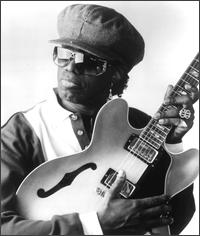 "The mothers of prevention" originally had different U.S. and European LP versions. Luckily it's all united on the current
CD version, because it's all worthwhile. The "porn wars" issue was American politics, but understandable for everybody, and
similar discussions are raised elsewhere as well. The CD was clearly compiled for the occasion. It's a mix of unreleased
recent material from Zappa's closet without being related, but with enough quality per item. The opening piece
"I don't even care" for instance has nothing in common with the two synclavier examples from below.
"The mothers of prevention" originally had different U.S. and European LP versions. Luckily it's all united on the current
CD version, because it's all worthwhile. The "porn wars" issue was American politics, but understandable for everybody, and
similar discussions are raised elsewhere as well. The CD was clearly compiled for the occasion. It's a mix of unreleased
recent material from Zappa's closet without being related, but with enough quality per item. The opening piece
"I don't even care" for instance has nothing in common with the two synclavier examples from below.
I don't even care, opening (midi file).
I don't even care, opening (transcription).
It features
Johnny Guitar Watson on a Zappa album for the third time. Zappa admired Watson as a guitar player. He was one of his examples
when he started to learn to play the guitar. On Zappa's albums however Watson was invited for his voice. He could
improvise in a funny agitated way and gets credited for the lyrics on this one. He's singing and talking
over a vamp all through, in this case made up of a bass movement and a chorus (bars 6-8, staff1). It's E Mixolydian, accompanied by
an ongoing E chord in 16th notes. Photo to the right of Watson downloaded,
source unknown.
2. One man, one vote
The A-B-A construction from "G-spot tornedo" (see the Jazz from hell section) is also used in "One man -
one vote" from "FZ meets the mothers of prevention". Whereas "G-spot tornado" is fit for human performance,
this applies less to "One man, one vote", because it's deliberately using the synclavier for
creating odd rhythms. This piece begins with two bars in standard 4/4. The B pedal sets the scale to B Mixolydian.
Next a vamp appears, lasting 34/16 and with an odd subdivision, over which
the melody of block A is played (first example from below). 34/16 reads uneasily, so it's very likely Zappa has it subdivided. Just by listening to the CD I can't tell
what division that might be. In the example below I've split the vamp into two times 17/16, but other subdivisions can be chosen just as well.
In 2005, when I included a smaller example, I used dashed lines.
Harmonically this is a very clear example of Zappa's love of uncommon chords. The vamp is made up of three layers, a bass line and two staves
for the middle range, one on each side of the stereo field. One is systematically playing Bsus2, the other B-F#, as a normal chord or as a broken chord.
Notable are the many occurences of fourths and fifths.
One man, one vote, 0:00-0:49 (midi file).
One man, one vote, 0:00-0:49 (transcription).

Use of intervals in the three layers of the vamp. The vamp lasts 34/16, as it's listed in my meters overview. A subdivision into two times 17/16
is only done for making it better readable. A subdivision as done by Brett Clement below is valid just as well. I'm hearing the voicing of the chords a little different,
but the notes from these chords are definitely in it.
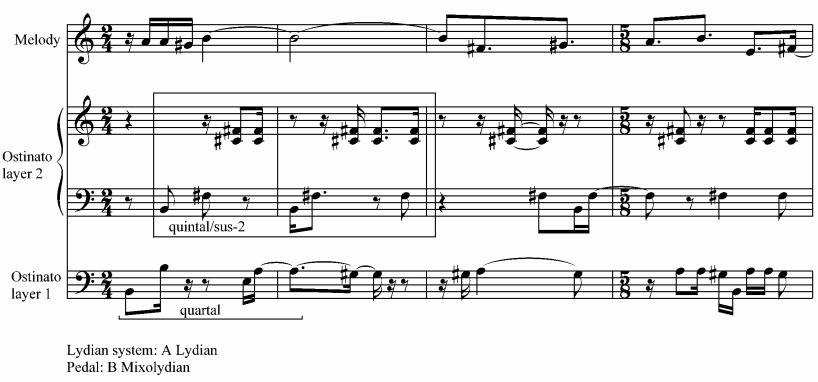
The occurrence of fourths and fifths during the vamp (ostinato figure) has also been noted by Brett, who's identifying a quartal and quintal chord
(stacked fourth and fifth). This last example is from page 312 of his 2009 study, where you can also find what he means by a Lydian system.
The intervals between the subsequent notes of the melody are given beneath. The numbers are the number of minor seconds of the interval,
+ is going upwards, - is going downwards. A jump from the last note of a bar to the next bar is
notated as the initial interval of the latter bar.
- Bar 7: +0-1+3.
- Bar 8: -5+2+1+2-7+2.
- Bar 9: (none).
- Bar 10: +0-1+1-1+1-1+3.
- Bar 11: -5+2+1+7-1.
- Bar 12: -4+2-4+2-5+3.
- Bar 13: -1+3+2.
- Bar 14: +2-6+7-1-4.
- Bar 15: +2+5+0.
- Bar 16: +0+0-2+2-2+2-2+7.
- Bar 17: -2+0-3+2-4.
- Bar 18: +5-8+3-1+6-3.
- Bar 19: +0-3+1-3.
- Bar 20: +0+0+2-6.
- Bar 21: +2+5-7+2+5-7+2.
- Bar 22: +5-7+2+5-1-6+2+2.
- Bar 23: +0+0+0+0+2-4.
- Bar 24: +10-5+7-12-2-1.
So also in the melody fourths and fifths turn up regularly. Notable is the recurring +2+5-7 motif from bars 21 and 22, using both intervals.
Variations can also be recognized. Bars 10 and 11 are an obvious variation upon the material from bars 7 and 8.
One man, one vote, 1:22-1:31 (midi file).
One man, one vote, 1:22-1:31 (transcription).
Block B contrasts sharply with block A. While the first block is purely Mixolydian, the latter is chromatic.
You might say the vamp offers a form of counterpoint during block A. Block B knows more explicit counterpoint lines.
Sometimes it goes parallel, at other instances you can hear three-part counterpoint as during the example from above.
This section knows varying meters, but offers little clues how it should best be notated. The meters in this example
are my notational choice. It's difficult to transcribe with both the music being dense and the tempo being high.
The synclavier pieces based upon note entry could be printed out from the machine, so it's kind of useless trying to transcribe much of this material in detail.
3. Little beige sambo
"Little beige sambo" is another synclavier piece, as well as the next track.
Several prints have already been handed out to orchestras (see the CDs and scores section).
In the L.S.O. section of this study you can find a paragraph about the chord bible, including
a quote with Zappa describing how he applied it to this track: "Little beige sambo started off as what we call the cream puff row ...
I have this compilation of material that we refer to as the chord bible. And the chords can be used as simultaneous blobs of sound,
or they can be arpeggiated in different ways. And then the cream puff row is the derivation of all of the more pleasant-sounding chords that happen to be
in the chord bible compilation". Even with information like this I consider it a stretch too far to start indentifying chord bible chords from the example below.
The principal problem is that you don't know how the notes should be grouped and you don't have any guarantee that each chord is indeed a chord bible chord.
The chords could be grouped in different manners:
- Any vertical combination. When you're taking the voicing of chords as relevant, as Zappa apparently did, you're soon getting at a large amount.
The number of theoretically possible chords has been investigated by mathematicians as Herald Fripertinger, of which I'm presenting some results in my discussion
with Brett Clement. See the left menu of this site for a link to his "Response to Kasper Sloots", with chapter V dealing with the chord bible.
- Bits of melody, interpreted as broken chords. Which notes from which staves should be combined is to a degree a matter of choice.
- Chords played as "blobs" on one instrument. Then there are only a few two-note combinations audible in this example.
- The 16th notes are played that fast, that they sound as arpeggio waves going up and down. Are these one chord or
series of chords, and how should they be subdivided?
Little beige sambo, 0:00-0:12 (midi file).
Little beige sambo, 0:00-0:12 (transcription).
The example above is made up of 14 bars in 4/4, lasting only 12 seconds. For humans one would say "as fast as possible", but that doesn't apply to
a synclavier and it's actually played faster as humanly possible. Some characteristics:
- Bars 1-4: several instruments are playing smaller and larger melodic lines, most of the time in a hocketing manner. These four bars are brightly diatonic.
There are no real tonics in this piece, at most you've got temporary local tonics. Upon the lowest note F it would be the set of F major.
Througout this piece you can hear motifs and melodies being varied upon. The opening returns at 1:30, the example above might thus be called the main theme.
- Bars 5-7 (beats 1-2): in bar 5 the A has altered to Ab. Next it's getting chromatic. Bars 6-7 are the first ones with an apreggio wave. It goes up and down
and over an octave, in neither way using the same notes.
- Bars 7 (beats 3-4) through 9: diatonic again. It begins upon G with the set of notes being the G Dorian collection.
- Bar 10: this sounds as a chord progression: fifths, a fourth, ending with F#m7. The last one is a standard chord, as often with Zappa, not expected to resolve.
The effect of chords also depends upon their context. A simple triad doesn't sound special in a composition using mainly triads, but it can come out strongly
when you play it in an atonal environment full of dissonants. In this case the F#m7 chord comes out more effectively, because the previous bars haven't been following
common patterns.
- Bars 11-14: these are pretty irregular, using diatonic scales in a fragmented manner. In bar 11, staff 4, you can recognize stacked fourths and fifths in a broken form.
This is also getting commented upon in the Jazz from hell section. These two chords are unconventional, returning frequently in his music, with the stacked
fourth being characteristic of the "Uncle meat main title theme". Very likely a stacked fourth was included in the chord bible.
4. Aerobics in bondage
"Aerobics in bondage" opens with two melodies that are alternating each other rapidly (that is when one staff holds a note, the other staff takes over the melody).
In the last three bars in the example the two melodies are getting to play more jointly, thus becoming more polyphonic regarding style.
Aerobics in bondage, opening (midi file).
Aerobics in bondage, opening (transcription).
The eighth note is used as the time unit all through these bars. Harmonically it’s another example that you can interpret either
as made up of scale fragments or as atonal/chromatic altogether.
This example apparently has no constant meter, and I can't guarantee what meters Zappa used typing it in. Above I've followed the returning
high E note to start a bar.
5. We're turning again
With "We're turning again" we're getting at a recording with Zappa's regular rock-band.
It's one last time kicking at remnants from the hippie era.
In his biography you can read why Barry Miles finds the lyrics of this song particularly tasteless. Tommy Mars appears to have disapproved of these lyrics
too, which might have been a reason for Zappa to comment that it can be interpreted differently (interview with John Swenson, Guitar world, March 1982):
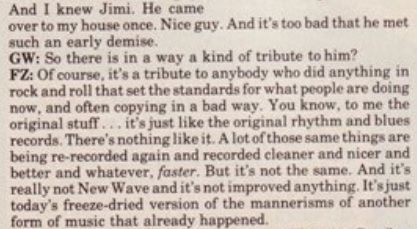
"Does humor belong in music" doesn't have a specific musical concept behind its content. The album lacks coherence but not quality.
In fact "We're turning again" is the only title on it, that you could call a normal pop-song, having lyrics and returning themes.
Tracks 5-6 and 8 belonged to the band's live repertoire during the eighties with other versions turning up on the "YCDTOSA" series.
All other titles are unique for "Does humor belong in music".
"We're turning again" is one of many songs that, next to a verse and a chorus, have many side-themes and interrupting figures. This subject has
also come by at "Inca roads" and "Dinah-Moe Humm". In fact, only half of the next example is taken up by the verse and chorus.
It's the opening of this song. The key is E Dorian and the meter 4/4, except for the side theme, that cause one bar to be extended to 6/4.
We're turning again, 0:00-0:37 (midi file).
We're turning again, 0:00-0:37 (transcription).
- Pick-up bar: fast string of 32nd notes.
- Bar 1 and bar 2, beats 1-2: chorus.
- Bar 2, beats 3-4: the first string returns.
- Bar 3 and bar 4, beats 1-2: the chorus once more.
- Bar 4, beats 3-4: second string of 32nd notes.
- Bar 5 and bar 6, beat 1: verse.
- Bar 6, beats 2-4 and bar 7: side theme ("It's over there ...").
- Bar 8 and bar 9. beat 1: the verse continues.
- Bar 9, beats 2-4: arpeggio figure.
This last argeggio chord can be seen as harmonic fill-in. It's the full major pentatonic chord upon A, sounding upon an open keyboard pedal.
6. Alien orifice
"Alien orifice" belongs to the series of scores that the ZFT offers (or used to offer) for rent to ensembles that want to perform Zappa's music. For
private persons the availability of these scores has become more and more difficult, which leads to the awkward situation that for this study I'm sometimes
forced to transcribing something that some other people already must have lying on their shelves. In this case the lead melody from the opening
is present in the Ludwig and Clement studies. I've transcribed the remainder rather detailedly from
the performance on "FZ meets the Mothers of Prevention". There are obviously version differences
between this execution and the 1981 live version that got released on YCDTOSA vol. VI, though the sections below are relatively similar.
There are also differences with the sheet music (see below at this paragraph). "Alien orifice" is made up of five instrumental blocks, with the final block being a reprise of the opening block followed by a coda. The opening
block contains the main theme, played twice. It's made up of four phrases of four bars each, that every time begin with the same rhythmic figure for their
first bar. What makes this theme interesting is that all phrases get harmonized in a different way. To be sure I have the scales identified correctly,
I had to transcribe the slow arpeggio-like figures in the second example as well. The opening block has something of a triple tonality.
The theme itself has A as its central note (in the Ludwig study it's presented as an example where Zappa is repeating notes in a melody). Next you've
got an ongoing Gsus2 chord by the rhythm guitar. The bass follows a jazz-type walking bass, thus the pedal notes are relatively weakly present. Taking these pedal
notes as tonic you get:
Opening block, first statement of the central theme:
- Bars 1-4: Eb Lydian. Apart from the Gsus2 etc. chord for the rhythm guitar, no other chords are used. It's audible lightly in the background, and you have
to listen carefully to notice that it changes a couple of times. The harmonic
climate, that surrounds the melody, is thus more determined by
the bass line.
- Bars 5-8: E minor (Aeolian).
- Bars 9-12: C Lydian.
- Bars 13-16: G Dorian.
Repetition of the central theme:
- Bars 17-20: Eb Lydian. The melody now gets played in the form of a series of 5th chords. The A now appears as the highest note of the F chord.
The transcription stops at bar 19. I'm continuing below with describing what you can hear on album.
- Bars 21-24: E Dorian. During bars 5-8 the C appears only once as natural. Here the A becomes part of the F#m chord with a C#, thus here it's E Dorian.
- Bars 25-28: C Lydian. The A becomes the D chord.
- Bars 29-32: G Dorian. The A becomes the F chord at first, but at its off-beat second appearance in bar
29 immediately turns over to Faugm, where it stays till bar 31, beat 1. Next you get the progression
F-Em-Fm-Bb-C-D-F#m etc.
Alien orifice, opening (midi file).
Alien orifice, section (midi file).
Alien orifice, opening (transcription).
Alien orifice, section (transcription).
Return of the central theme during the final block (2nd example):
- Bars 1-4: G minor (Aeolian). The Gsus2 chord does not return. The bass is now more clearly playing pedal notes. Here you've got chords/scales as strings in the form of arpeggios, and some uncommon wider chords.
In bar 1 it's II 7th (or Am7-5). In bars 2-3 it's VII 9th.
- Bars 5-8: Bb minor variant. The series of notes used here is Bb-C-Db-Eb-Fb-G-A, thus not a standard diatonic scale. In bar 8 the F, as played by the bass,
becomes natural again.
- Bars 9-12: A Mixolydian. Some chromatic elements are added: the Eb in the figure from staff 1 in bar 10, and the Bb in staff 2 in bar 11.
- Bars 13-16: C Dorian. Again a chromatic element turns up by the F natural switching to F# in bar 16.
After this bar the coda begins. "Alien orifice" and more specifically "Aerobics in bondage" have wild codas. Since both pieces are multi-scale, there is no standard coda
to end with. It could end in every manner and Zappa takes advantage of this by also letting the coda jump through a number of scales. At the end
it looks likes Zappa wants to close this piece in E minor, but the final chord is simply the D chord (VII in E minor or moving over to I from D Mixolydian).
THE MINOR-LYDIAN CHORD
The number of examples in this study, that compare the sheet music with the albums, show that it is more a rule than exceptional that album
versions differ from the sheet
music (see also the Uncle Meat section).
"Alien orifice" seems to be yet another example of the score and CD going differently. In the study by Brett Clement you can find two examples from what must
be the score the ZFT has for rent. During the reprise Brett found examples of what Tommy Mars has referred to as the "minor Lydian" chord. Upon C he describes it as
the Cm chord mixed with the D chord (Clement 2009, p. 207). The chord you're then getting at is C-D-Eb-F#-G-A. The minor third explains the "minor"
part of the term, while the augmented fourth is typical of the Lydian scale. The score version appears to have pedal notes/chords as follows (pages
368-9 of the Clement study):
Initial statement of the theme:
Phrase 1 (bars 1-4 of my 1st example): EbM7, the scale-chord combination then becoming Eb Lydian.
Phrase 2 (bars 5-8): Em11 and E Dorian.
Phrase 3 (bars 9-12): CM7 and C Lydian.
Phrase 4 (bars 13-16): Gm and G Dorian.
Alien orifice, reprise (score).
Reprise of the theme:
Phrase 1 (bars 1-4 of my 2nd example): G-C-Eb-F-Bb-D-A.
Phrase 2 (bars 5-8): Bb-F#-G-C#-D-E-A or the G minor Lydian chord in a different following order with an additional F#.
Phrase 3 (bars 9-12): A-C-D#-E-G-B-F# or the A minor Lydian chord in a different following order with an additional G.
Phrase 4 (bars 13-16): B-C-Eb-G-D-F#-A or the C minor Lydian chord in a different following order with an additional B.
As you can see the pedal notes and scales of the initial exposition of the theme are (largely) the same, but the chords being played on
"FZ meets the Mothers of Prevention" are different. Phrase one of the reprise goes similar in both versions. The use of the minor Lydian chord during
phrases 2-4 is specific for the score version. Its root notes are still returning as pedal notes on album for phrases 2-3, but
here the harmonies are forming figures, that are moving more freely. For phrase 4
the album version is using a C as pedal note instead of a B.
Why Brett calls phrase one of the reprise C Dorian gets explained on page 212 of his study:
"For the accompaniment of the reprise, Zappa provides both chord
symbols (not given) and pitch-space realizations of these symbols. As can be seen, these
realizations are all seven-note Chord-Bible harmonies. Of these, only the chord accompanying
phrase 1, the diatonic D[5-3-2-5-4-7], is unconfirmed. Though the lowest note of this chord is G,
Zappa’s chord symbol (not given) indicates C as its true root." The D[...] notation stands for the pitch-space realizations (number of
minor seconds intervals between the subsequent notes). Apparently Zappa
also used chord symbols, indicating the root notes, which Brett used for writing out the chords in the first bar of each phrase.
See his own study or the left menu of this site for what he means by Chord-Bible harmonies.
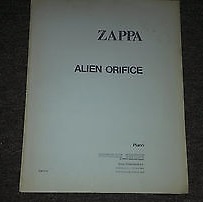
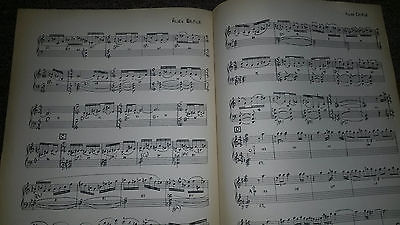
Thumbnails of the Alien orifice piano score
7. Yo cats
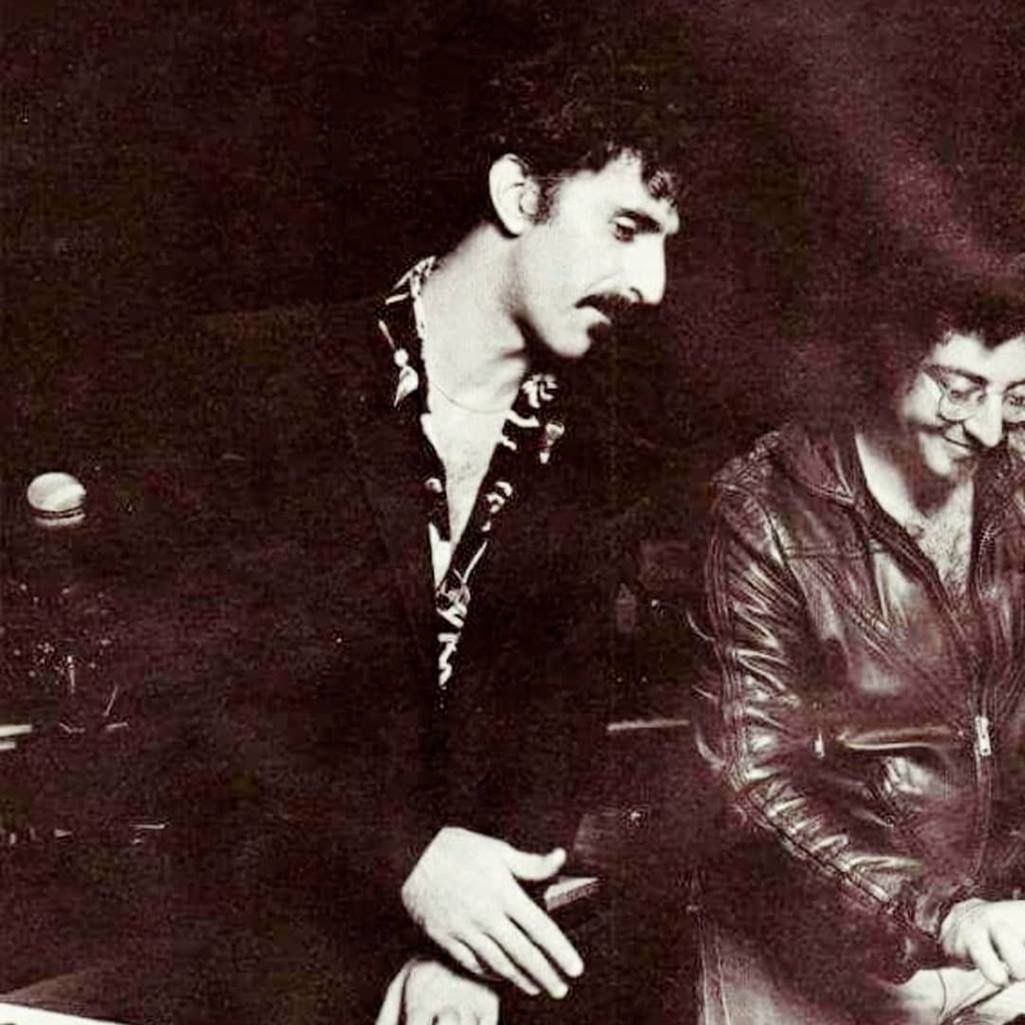 The music of "Yo cats" was co-written with Tommy Mars, credited under his official name Mariano (to the right a photo of him and Frank, photographer unknown). It's sung by Ike Willis
with basic accompaniment. The lyrics (by Zappa) are using that many slang expressions, that in this case some explanation as in the Slaven
and Russo books is welcome. It appears to be about session musicians seeking ways to maximize their income at the expense of others.
The music of "Yo cats" was co-written with Tommy Mars, credited under his official name Mariano (to the right a photo of him and Frank, photographer unknown). It's sung by Ike Willis
with basic accompaniment. The lyrics (by Zappa) are using that many slang expressions, that in this case some explanation as in the Slaven
and Russo books is welcome. It appears to be about session musicians seeking ways to maximize their income at the expense of others.
SWING
Yo cats, 0:00-0:26 (midi file).
Yo cats, 0:00-0:26 (transcription).
The example above is its main theme. Notable are the many instances of chords played before beat and the abundant use of triplets.
It gives this theme an outspoken swing rhythm, jazz-like. During this example you have to count fast like one-and-two-and-three-and-four etc. with the "and" lasting a 16th note in triplet time.

Regular notation compared to a swing time execution according to Wikipedia.
Only nominally this piece can be attributed to F Dorian, that is it starts like that. Both the tonic and key are volatile in this piece with notes altering frequently.
The chord progression of the main theme goes as:
- Bar 1: Fm-Bb, Bbm - Ab+C+F+Bb.
This last chord is a stacked fourth played upon an Ab by the bass, an incomplete Cm13 chord.
- Bar 2: Fm-Bb, Bbm - Eb - D+5.
This bar being a variation upon bar 1, ending differently. Both are ending with a less common chord.
- Bar 3: Dm7-G, Eb-G.
Only the pattern from bars 1-2 is maintained, the chords are all different. The bass now plays like a walking bass, adding
extra notes to the overall harmony.
- Bar 4: Dm7-G, E-5 - Cm.
Variation upon bar 3.
- Bar 5: Fm-G, Bb - Eb+5 -C.
- Bar 6: Am7 - E-5 - C - E-5, Dmaj7+5 - Bm - Dmaj7+5 - F#m.
Beats 3-4 of bar 5 and bar 6 can be called the second phrase of the main theme. It's drifting far away from the initial start in F Dorian.
8. What's new in Baltimore? (1982)
"The mothers of prevention" album sleeve hardly gives any information about the recording dates. The personnel stems from
both the 1982 and 1984 tours. Apparently Zappa didn't feel like including live material from the 1984 tour, for which he
already had a CD in mind.
What's new in Baltimore (1982), 0:32-0:57 (midi file).
What's new in Baltimore (1982), 0:32-0:57 (transcription).
"What's new in Baltimore" exists in three versions. One from the 1982 tour, one from the 1984
tour and the one on "The mothers of prevention". According to the bootleg collectors this
last version is the way the band played the song during the 1981 tour. There are also two musical reasons for
why this version precedes the other two. First it's played closer to the draft score as Zappa probably wrote it down. That is a
lead melody, bass pedal notes and chord indications. The Ludwig study includes a transcription of the "The mothers of prevention"
version in this form. The 1982 version, transcribed here, already includes an amount of freedom that you can take when
you're playing it for a while. The bass opens a bar with a pedal note, the vibes take care of the lower notes of the melody
and the keyboard has its accents on the higher notes. For the remainder the parts don't have to be in exact parallels.
Secondly the 1982 version is played a bit faster and the 1984 version considerably faster. The metronome tempos of a quarter note are approximately:
- The mothers of prevention (1981): 150.
- YCDTOSA V (1982): 155.
- Does humor belong in music? (1984): 175.
The song is made up of two almost unrelated halves. The opening part is a sequence of various shorter melodies in meters and keys that
keep changing. The transcribed part shows the use of 5/8, 4/8, 3/4 and 7/8. The opening melody (bars 1-6) is in E Dorian.
Bars 7-8 are making a transition. The second theme (bars 9-16) is in E. Bars 17-20 offer an atonal/chromatic variation upon the
opening theme, now including counterpoint lines. Bars 21-22 get repeated. They are diatonic again, but without a clear key note. The second half of the song, on the other hand,
is a guitar solo in normal 12/8 (or 4/4 with triplets) with only the last chord of the first half making a link. See the
"What's new in Baltimore? (1984)" version from the
Does humor belong in music? section for the second half of this song.
9. Porn wars
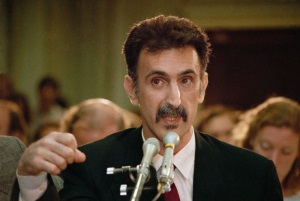 "Porn wars" is the centerpiece of the album, lasting 12 minutes. It's a collage, constructed with the aid of the synclavier.
You can hear a number of senators speak during the Senate's committee hearing, addressing the issues the PMRC had brought up.
This PMRC, the Parents' Music Resource Center, was headed by a number of wives of politicians. Elizabeth "Tipper" Gore being
the most prominent member. Both she and her husband are among the people listed in the album liner notes. The statements by
the senators aren't directly commented upon, but indirectly mocked at by putting their words in a loop mingled with synclavier
samples.
"Porn wars" is the centerpiece of the album, lasting 12 minutes. It's a collage, constructed with the aid of the synclavier.
You can hear a number of senators speak during the Senate's committee hearing, addressing the issues the PMRC had brought up.
This PMRC, the Parents' Music Resource Center, was headed by a number of wives of politicians. Elizabeth "Tipper" Gore being
the most prominent member. Both she and her husband are among the people listed in the album liner notes. The statements by
the senators aren't directly commented upon, but indirectly mocked at by putting their words in a loop mingled with synclavier
samples.
Above: Zappa addressing the Senate's committee for Science, commerce and transportations, September 1984.
Very roughly the outlines go as:
0:00 Senator Danforth: "The reason for this hearing ..."
0:21 Senator Hollings: "I've had the opportunity ..."
1:32 Collages #1, "Rape, incest, it's outrageous filth ..."
Porn wars, 1:32-1:41 (midi file).
Porn wars, 1:32-1:41 (transcription).
The example above is the opening bars of this collage section #1. The synclavier starts normally in 4/4, but the spoken
parts are put on top of it in a deliberate irregular way. They are made up of snippets of some words from the senators testimonies, sped up and slowed down at will,
while the rhythm of the spoken words is superimposed upon the 4/4 basis irregularly. It's meant to create a chaotic atmosphere with people speaking through each other, while the sustained
notes of the synclavier offer some relative calmness. It's difficult to catch spoken words in midi format, so
the two midi examples in this paragraph sound less recognizable than elsewhere in this study. When composing on the synclavier, Zappa typed in the drum part too. In this case
I've included this part in the transcription, being an essential element in the written composition.
Literally putting the collage parts on paper is terrible. What you can see happening here is two text parts,
reciting the same words, but in a different manner. The pitches are unequal and the rhythm is uneven most of the time. In bar 3 the words "of such lyrics"
start equal. In bar 4 everything is uneven, not just the two voices among themselves, but also their relationship with the synclavier part.
In bar 5 the words "it's outrageous filth" get sped up. This is getting more and more exaggerated throughout the piece, to the point of
making "maybe I can make a better rock star" sounding like some sort of a disco jingle between at 6:40 and 7:22.
3:18 1967 Piano people (see the Lumpy Gravy section): "This must be the end of the world ...".
3:27 Collages #2, "What is the reason for these hearings ...", "sex ...".
4:02 Collages #3, Senator Hawkins: "I might be interested what kind of toys your kids ever had."
5:50 Collages #4, Senator Gore: "I find your statement very interesting ...".
6:08 Collages #5, "Wait a minute ... maybe I can make a better rock star ...".
6:21 1967 Piano people: "They don't even understand their own music ...".
6:41 Collages #5 cntd.
7:23 Collages #6, "Rock, rock, porn rock ...".
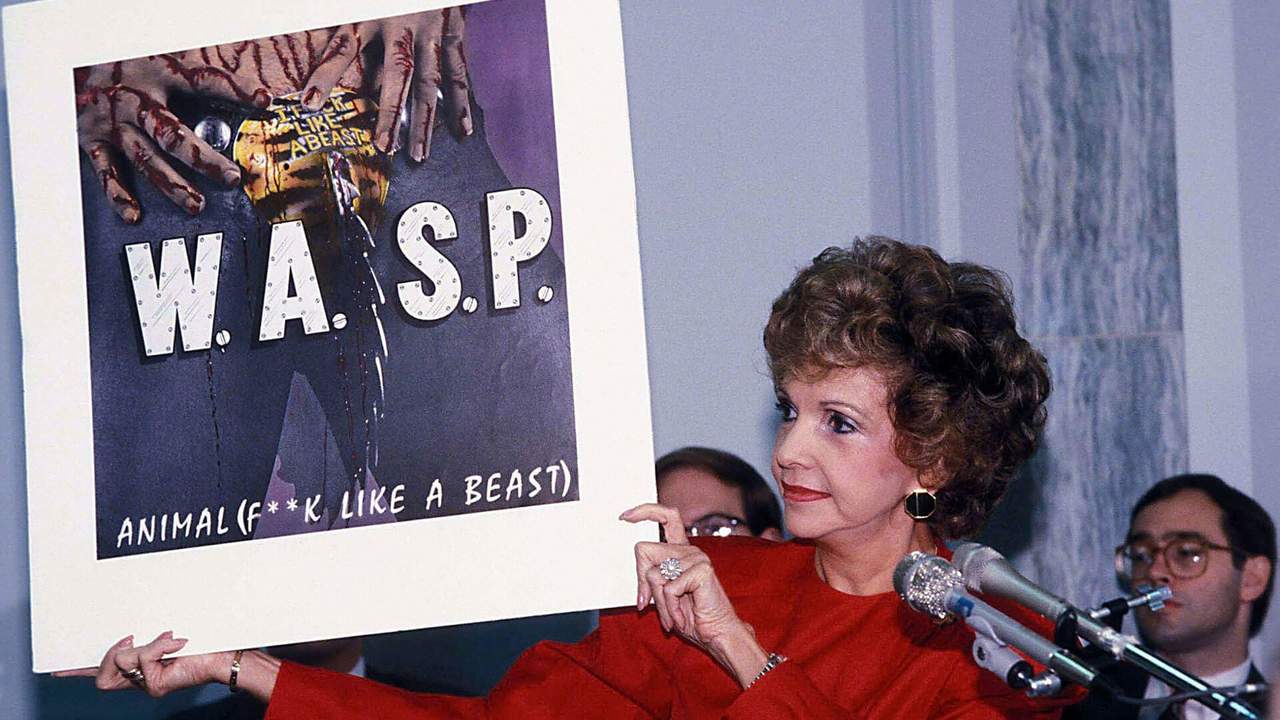

Senator Paula Hawkins holding up an album cover she deemed repulsive. The issue Zappa raised was not so much
if such albums should be seen as offensive, but if forbidding such material belongs to the territory of legislation.
He considered the idea in conflict with the U.S. constitution. Senator Ernest Hollings (to the right) clearly had a different approach,
saying that if he could find some way constitutionally to do away with it he would. His statement turns up unaltered at the beginning
of "Porn wars", offering most texts for the collages. Zappa strongly opposed the idea of censorship in any form, being the subject
for the fictional works "Joe's garage" and "Thing-Fish". His arrest in 1965 for recording pornographic material and the actions
by the PMRC showed that some of his suspicions could be real.
8:13 Thing-Fish: "We will get back to the whi(m)p ...".
8:27 Rock music, "I see some of y'all be frowning ...".
Porn wars, 8:27-8:37 (midi file).
Porn wars, 8:27-8:37 (transcription).
This is the only section, that you could call musically standard with a rock progression in 6/8, though not consistently so. As you can see, the bass part is using
a subdivision into four during the second half of bars 2-4, as if playing in 4/4 at these points. For the lyrics Zappa is re-using lines from
"Galoot up-date" from "Thing-Fish" unaltered, as he's also doing with the 1967 piano people. He lets these citations express his opinion, rather than
using his own words from his testimony. Like above with the senators, the text by "Thing-Fish" is spoken and superimposed upon
the rock theme in an irregular manner. He did give many interviews that expressed his ideas more directly and the ZFT has released his integral testimony
on their release "Congress shall make no law". Harmonically this rock passage is a chord progression in F# minor. It begins with a F#m/F#m7 - D alternation,
repeated a few times. The example above has this alternation two times. Next it gets followed upon by A - A (augmented 5th) - D - A progression
over an A pedal by the bass, thus a modulation to A Mixolydian or major.
9:24 Collages #6, Senator Gorton: "Mr. Zappa, I am astounded ...".
During this collage, material from next track, "H.R. 2911", can be heard as the accompanying music. The example below is audible between 9:53 and 10:03.
11:42 Collages #6 cntd., "Mr. Zappa, thank you very much for your testimony ...".
12:03 End.
10. H.R. 2911
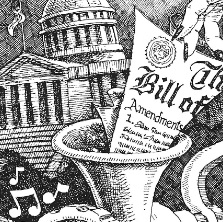 "H.R. 2911" is another collage, this time solely made up of synclavier samples. Sections of it can also be heard as background music during "Porn wars". The title is the code for
a law proposal that would tax blank recording tapes. This tax would be returned to the copyright holders of the music
the people would probably copy on these tapes at home.
By itself it had nothing to do with the PMRC proposals, but it was thought that
a combination of regulations could make the record industry more receptive to the ideas of the PMRC. Eventually no laws were made,
but parental advisory stickers did turn up for a while. To the right an outtake from the CD backside drawing by John Dearstyne.
"H.R. 2911" is another collage, this time solely made up of synclavier samples. Sections of it can also be heard as background music during "Porn wars". The title is the code for
a law proposal that would tax blank recording tapes. This tax would be returned to the copyright holders of the music
the people would probably copy on these tapes at home.
By itself it had nothing to do with the PMRC proposals, but it was thought that
a combination of regulations could make the record industry more receptive to the ideas of the PMRC. Eventually no laws were made,
but parental advisory stickers did turn up for a while. To the right an outtake from the CD backside drawing by John Dearstyne.
H.R. 2911, 1:25-1:36 (midi file).
H.R. 2911, 1:25-1:36 (transcription).
This piece knows no themes in its standard definition. It rather sound as one big through-composed melody, hocketing with its notes
popping up in quite a number of staves. Just 11 seconds already takes up a page. It's made up of motifs, note-strings and sustained notes.
Combined you're getting at some sort of harmonized melodic line, accompanied by snorks and other undefined sound samples as well. Apart from these
snorks it sounds as chamber music with a percussion section. I can't include these snorks in midi format, but I've indicated them
at the bottom of the score. For this reason the midi file sounds less recognizable than I'd wish. The synclavier at this point had sounds imitating acoustic instruments, but not with the quality
of how Zappa added them later on by sampling real acoustic instruments.
Other collages as "N-lite" and "Beat the reaper" can contain regular themes (see the Civilization phaze III section). The constant factor in
"H.R. 2911" are the bass drumbeats. Listening to the record it's impossible to discern downbeats, so I can't tell where Zappa may have put the meter
lines. I've used dashed lines in the example just for readability, as if it's in 4/4.
